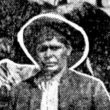Loading map...

Broughton (also known as Toodwick, an anglicized version of his Aboriginal name) was an Aboriginal man from the lower Shoalhaven River in the vicinity of Coolangatta Mountain, or Cullunghutti as it was originally recorded. Born in the late 18th century, he worked as a young man for Charles Throsby of Liverpool and later as a guide for John Oxley. On the recommendation of Throsby, Broughton was engaged by Alexander Berry in 1822 at his extensive land grant near the mouth of the Shoalhaven River which he owned with his business partner Edward Wollstonecraft. Broughton accepted the opportunity to return to his traditional country.[ref]Michael Bennett 2003, For a Labourer Worthy of His Hire: Aboriginal Economic Responses to Colonisation in the Illawarra and Shoalhaven, 1770-1900, unpublished PhD thesis, University of Canberra; Keith Campbell, ‘Broughton (1798–1850)’, Australian Dictionary of Biography, National Centre of Biography, Australian National University, http://adb.anu.edu.au/biography/broughton-12820/text23143, published first in hardcopy 2005, accessed online 7 February 2019.[/ref]
Broughton was important to Berry in various ways. He acted as a cultural broker for Berry who was attempting to establish his pastoral and agricultural enterprise on land taken from Traditional Owners. Convicts were Berry’s main source of labour, although he relied heavily on Aboriginal workers to tend animals and harvest crops. It is likely that Broughton assisted with the recruitment of Aboriginal workers. He also helped to build Berry’s homestead, although he was ridiculed by his relatives for doing the work of convicts. Sometimes, he used his knowledge of the land to deliver messages, travelling as far as Pennant Hills in Sydney’s north where Berry had another land grant.[ref]Michael Bennett 2003, For a Labourer Worthy of His Hire: Aboriginal Economic Responses to Colonisation in the Illawarra and Shoalhaven, 1770-1900, unpublished PhD thesis, University of Canberra; Ralph Hawkins 1994, The Convict Timber Getters of Pennant Hills, Hornsby Shire Historical Society.[/ref]
Berry also made use of Broughton’s tracking skills, particularly in the recapturing of escaped convicts. He awarded Broughton a brass breastplate with the inscription of “Constable”. Controversially, Broughton was asked to pursue another Aboriginal man named Brogher (either his brother or close relative) who was wanted for the murder of a timber cutter. Broughton led the authorities astray, although Brogher was later captured and executed. The case exemplifies the fine line that Broughton had to walk between two cultures.[ref]Keith Campbell, ‘Broughton (1798–1850)’, Australian Dictionary of Biography, National Centre of Biography, Australian National University, http://adb.anu.edu.au/biography/broughton-12820/text23143, published first in hardcopy 2005, accessed online 7 February 2019.[/ref]
In later life, Broughton and his wife of the time (he had three in all) collected rations from Berry and seemingly lived a quiet life. It is uncertain when he passed away. His named lived on in the person of William Broughton, an Aboriginal man associated with the Shoalhaven River and Illawarra, and probably Broughton’s son. William Broughton’s partner was Hannah Lyons (also Hannah Jaber) and the couple had at least five children. Many descendants live in the Shoalhaven district today. The accompanying image of Broughton was drawn by French explorer Jacques Arago and is published courtesy of the State Library of NSW. [ref]Michael Bennett 2003, For a Labourer Worthy of His Hire: Aboriginal Economic Responses to Colonisation in the Illawarra and Shoalhaven, 1770-1900, unpublished PhD thesis, University of Canberra; Empire 18 July 1861: 8; Death Certificate of Minnie Longbottom 1889/010647; Death Certificate of James Broughton 1893/015171; Death Certificate of William Broughton 1914/005322; Death Certificate of Theresa Bran 1926/649. SLNSW PXB 283[/ref]

 This website explores the history of Aboriginal trackers in NSW from 1862 when the current NSW Police Force was established through to 1973 when the last tracker, Norman Walford, retired. You can read about the lives of individual trackers and some of the incredible tracking feats they...
This website explores the history of Aboriginal trackers in NSW from 1862 when the current NSW Police Force was established through to 1973 when the last tracker, Norman Walford, retired. You can read about the lives of individual trackers and some of the incredible tracking feats they...

There were over 200 NSW police stations that employed Aboriginal trackers between 1862 and 1973. Many were concentrated in the central-west and north-west of the state, the agricultural and pastoral heartland of NSW. This is because one of the main jobs of trackers was to pursue sheep, cattle and horse thieves. Trackers sometimes lived in small huts out the back...
Learn More ►
Pathfinders book Pathfinders, A history of Aboriginal trackers in NSW, written by Dr Michael Bennett and published by NewSouth, is now available from all good bookstores. Click on the link below to order your copy. https://www.abbeys.com.au/book/pathfinders-a-history-of-aboriginal-trackers-in-nsw.do Early History Since the beginning of the colony, government agencies, explorers, surveyors and members of the general public called upon the tracking...
Learn More ►